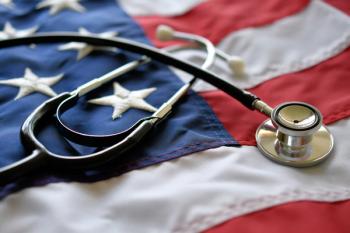
Higher BMI Linked to Lower Mortality Rate, Fewer Complications in Non-CF Bronchiectasis
Key Takeaways
- Overweight and obese patients with non-CF bronchiectasis showed lower all-cause mortality and reduced risks for critical health outcomes compared to normal weight patients.
- Underweight patients faced significantly higher mortality and increased risks for critical care, ventilation use, pneumonia, and acute respiratory failure.
Being overweight or obese may lower all-cause mortality risks in non–cystic fibrosis (CF) bronchiectasis patients, while being underweight increases health complications.
Being overweight or obese may protect against all-cause mortality and other critical health outcomes in patients with
Past research has
They used data from TriNetX, which
The researchers categorized patients by BMI, as classified by the National Institute of Health and the World Health Organization: underweight (< 18.5 kg/m2); normal weight (18.5-24.9 kg/m2); overweight (25-29.9 kg/m2); and obese (≥ 30 kg/m2). They used propensity score matching to ensure comparability between the normal weight group and the other 3 groups.
Patients were followed for at least 5 years from their diagnosis to evaluate the impact of BMI on disease prognosis. The primary outcome was all-cause mortality. Secondary outcomes included the need for critical care, mechanical ventilation, and ventilation dependence, as well as the incidence of pneumonia, acute bronchiectasis exacerbations, acute respiratory failure, and tuberculosis or non-tuberculous mycobacterial (NTM) infection.
Among the 14,469 patients in the study cohort, 5925 (40.9%) were of normal weight, 5076 (35.1%) were obese, 2494 (17.2%) were overweight, and 974 (6.7%) were underweight. The mean (SD) BMIs were 16.2 (1.5) kg/m2 for underweight, 21.9 (1.6) kg/m2 for normal weight, 27.4 (1.2) kg/m2 for overweight, and 36.0 (4.3) kg/m2 for obese patients.
The underweight group had a significantly higher all-cause mortality rate than the normal BMI group (24.3% vs 15.3%; HR, 1.83; 95% CI, 1.49-2.25; P = .0150). In contrast, mortality was lower among the overweight (16.6% vs 21.4%; HR, 0.77; 95% CI, 0.8-0.88; P = .0138) and obese (16.8% vs 20.2%; HR, 0.79; 95% CI, 0.71-0.87; P = .0356) groups.
The underweight group also faced significantly higher risks for several critical health outcomes compared with the normal BMI group, including the need for critical care (HR, 1.59; 95% CI, 1.23-2.06; log-rank P = .0003) and ventilation use (HR, 1.68; 95% CI, 1.17-2.42; log-rank P = .0042), as well as the incidence of pneumonia (HR, 1.44; 95% CI, 1.23-1.69; log-rank P < .0001) and acute respiratory failure (HR, 1.34; 95% CI, 1.03-1.75; log-rank P = .0265).
Conversely, the overweight group had reduced risks for critical care needs (HR, 0.80; 95% CI, 0.68-0.95; log-rank P = .0112) and ventilation dependence (HR, 0.53; 95% CI, 0.32-0.99; log-rank P < .0001), along with a lower incidence of acute respiratory failure (HR, 0.78; 95% CI, 0.66-0.92; log-rank P = .0032), pneumonia (HR, 0.71; 95% CI, 0.64-0.79; log-rank P < .0001), tuberculosis or NTM infection (HR, 0.42; 95% CI, 0.34-0.52; log-rank P < .0001), and acute bronchiectasis exacerbations (HR, 0.61; 95% CI, 0.52-0.72; log-rank P < .0001).
Similar protective effects were seen in the obese group, including lower risks of pneumonia (HR, 0.84; 95% CI, 0.77-0.91; log-rank P < .0001), acute exacerbation of bronchiectasis (HR, 0.55; 95% CI, 0.48-0.63), ventilation dependence (HR, 0.56; 95% CI, 0.38-0.81; log-rank P < .0001), and tuberculosis or NTM infection (HR, 0.19; 95% CI, 0.15-0.23; log-rank P < .0001).
The researchers acknowledged several study limitations, including the lack of data on disease severity and physical measurements, which could significantly influence patient outcomes. Additionally, because the data were obtained from electronic medical records, they are prone to coding and decoding errors. Given these limitations, they emphasized the need for further research to confirm and expand upon their findings.
“Whether an increased BMI due to nutritional support or lifestyle modifications can alter the clinical outcomes of underweight patients with bronchiectasis remains unknown,” the authors concluded. “Further prospective studies are required to validate these findings.”
References
- Hsu WH, Shiau BW, Wei YF, Lai CC, Chen CY. Impact of body mass index on outcomes of non-cystic fibrosis bronchiectasis. BMJ Open Respir Res. 2025;12(1):e002488. doi:10.1136/bmjresp-2024-002488
- Chalmers JD, Goeminne P, Aliberti S, et al. The bronchiectasis severity index. An international derivation and validation study. Am J Respir Crit Care Med. 2014;189(5):576-585. doi:10.1164/rccm.201309-1575OC
- Palchuk MB, London JW, Perez-Rey D, et al. A global federated real-world data and analytics platform for research. JAMIA Open. 2023;6(2):ooad035. doi:10.1093/jamiaopen/ooad035
Newsletter
Stay ahead of policy, cost, and value—subscribe to AJMC for expert insights at the intersection of clinical care and health economics.





























































